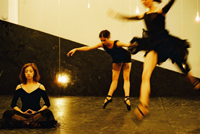Five guys. Playing games. What is going on in their minds? These production taglines for DNA Theatre’s newest radical ballet were the extent of the dramaturgical information available for the audience to process Red Light Green Light. In the weeks preceding the show, the dissemination campaign had been strategically restricted to those three phrases, creating a mysterious and anticipatory aura around the event. Even the house program notes were sparse, limited to credits and acknowledgements.
Showing up at the newly relocated Theatre Centre in Toronto very close to curtain call, I did not have the time to read through the hanging pieces of paper making up the lobby installation. Later, I learn that these consist of process notes for the work by DNA’s artistic director, Hillar Liitoja. Instead, I entered a perplexing scene in which a woman aggressively pointed to selected audience members waiting in the lobby while shouting “YOU! YOU! YOU!” before ushering them into the dimly lit performance space, one small group at a time.
Walking in with the second-to-last of those groups, choice of the U-shaped configuration of seats was now limited and I choose a chair at floor level, stage left, facing into the action. From my vantage point, I take in a set table downstage, at which a man and a woman are seated across from the dance space, stoically observing five male performers — Justin da Luna, Ryan Lee, Kealan McLaughlin, Jeremy Nasmith, and Kevin Rees — in rehearsal clothes. The theatre walls are exposed and the set-up is clearly reminiscent of an audition. The tension is palpable; the energy, dark.
The dancers stagger and stand immobile in the centre of individual, crisp-edged pools of white light. The two seated at the table put on heavy-duty hearing protectors, their movement direct and economical, before the man, Liitoja himself, picks up a handgun and detachedly shoots upwards. The sound is deafening.
In contrast to the audience, the dancers are not startled, as if having been desensitized over time. Instead, the shot sets them into motion: they each perform their own ballet-derived phrase. Their paths through space are clearly defined; they may cross one another’s trajectory, but do not physically interact. Eventually, they return to the reappearing pools of light, hold still for a tension-filled, uncomfortable amount of time, and Liitoja shoots again. The dance phrases resume, on different paths this time, eventually returning to the pools of light. More stillness, another gunshot, another phrase, repeating the pattern twenty-four times in total, testing the audience’s endurance through litany.
Over the course of this clock-like cycle between blasts, the dancers display modulations in emotional tonality that are subtly expressed and do not appear to follow a narrative. Each of them proves to be a remarkably accomplished technician, using their physicality in rigorous ways. Although not all of the performers identify as ballet dancers primarily — for example, Ryan Lee hails from the contemporary genre — the movement is well-embodied by all parties. Each of their individual movement signatures is very clear and, as a result, each dancer is revealed in his distinctiveness; a departure from the ballet form’s usual preference for homogeneity.
As gunshot succeeds gunshot with metronome-like physical and emotional regularity and a detached precision, a noteworthy variation comes through Rebecca Picherack’s lighting. Twenty-four large bulbs hang upstage and, with each detonation, a new one lights up. By the end of the work, all of them are bright, not dimming or changing in any way when the five dancing men finally leave the space, apparently of their own volition. The bulbs remain at full brightness, the shooters, impassive. The game is seemingly over, yet the purposeful theatrical incongruities make the ending ambiguous and a tense silence hovers over the unsure audience. On the evening I attend, this lasts for a good two minutes before a fellow attendee musters the courage to initiate the clapping.
Do I enjoy my experience? Not particularly. I feel trapped: I am left to fill time with my own inner dialogue in an environment that inspires the worst of conversations. Does it send me home thinking? Most definitely. I think about radicalism and its definition — whether it can be self-proclaimed when it comes to creativity. Not debating the fact that it can certainly be applied when it comes to form, I also recognize that the notion of radical ballet is plausible. That being said, does radicalism automatically need to be identified with harshness and underlying aggressiveness, or is the violent edge simply an area of artistic interest in Liitoja’s case, running a parallel course?
Tagged: Ballet, Choreography, Contemporary, Performance, ON , Toronto





